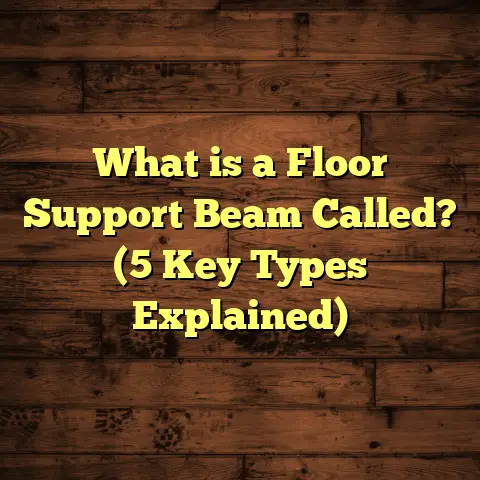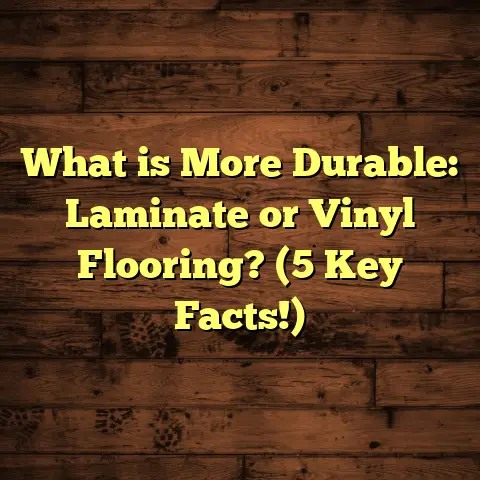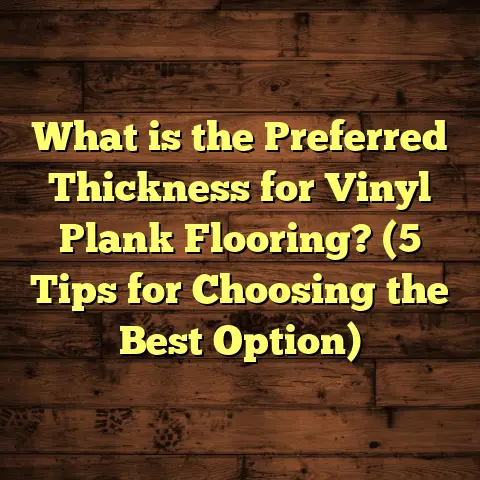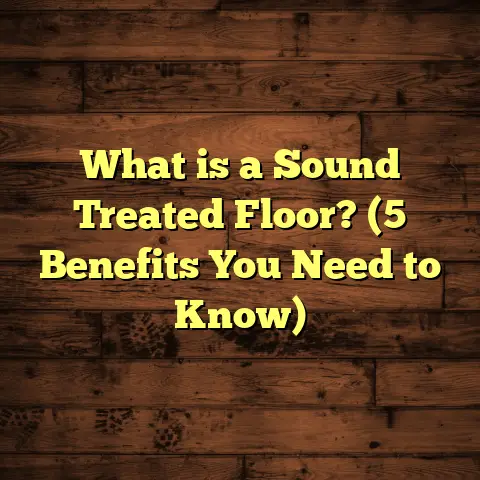What is Semi Solid Wood Flooring? (5 Benefits You Need to Know)
Smart homes are all about making life easier, more efficient, and stylish. When I think about how flooring fits into that vision, it’s not just about looks but also about durability, comfort, and smart choices that complement the overall home environment. One type of flooring I’ve come to appreciate a lot is semi solid wood flooring. You might have heard about it, but what exactly is it? And why should it matter to you if you’re considering new floors?
What is Semi Solid Wood Flooring?
Semi solid wood flooring is a type of engineered hardwood that combines the best qualities of solid hardwood and engineered flooring. Unlike traditional solid wood planks, which are made from a single piece of wood throughout, semi solid wood flooring has a thicker top layer of real hardwood bonded to multiple layers of plywood or other wood materials underneath.
Think of it as a hybrid — it has a real hardwood surface that gives you that natural wood texture and appearance, but its layered core provides enhanced stability and resistance to moisture compared to pure solid wood.
Here’s a simple breakdown:
- Top Layer: Usually 3-6 mm thick hardwood veneer (like oak, maple, or walnut).
- Core Layers: Several layers of plywood or high-density fiberboard (HDF) arranged crosswise.
- Backing Layer: Sometimes includes a stabilizing backing to reduce warping.
The thickness of the top veneer in semi solid wood flooring is greater than what you’d find in standard engineered wood, offering more sanding and refinishing potential over its lifespan. This makes it a practical choice for homeowners who want both beauty and longevity without dealing with some of the drawbacks of solid hardwood.
Why Did I Start Using Semi Solid Wood Flooring?
When I first started installing floors years ago, solid hardwood was the gold standard. But it had its issues — it could expand and contract with humidity changes, leading to gaps or buckling. Engineered floors offered better stability but sometimes felt less “real” underfoot because their top veneer was thin and couldn’t be refinished much.
Semi solid wood struck the right balance for me. One project that stands out was for a client in a coastal area where humidity swings were common. We chose semi solid flooring, and after three years, the floor still looked flawless with no warping.
A Closer Look at Semi Solid Wood Flooring Construction
To really understand why semi solid wood flooring performs so well, it helps to look at how it’s built.
The Top Veneer Layer
This is the part you walk on and see. It’s made from genuine hardwood species like oak, cherry, walnut, or maple. The thickness here is key. Semi solid floors typically feature a veneer between 3mm and 6mm thick—substantially thicker than the 1-2mm veneer on many engineered floors.
Why does this matter? Because thicker veneers allow multiple rounds of sanding and refinishing. This means if your floor gets scratched or worn down, you aren’t stuck with a permanent flaw or forced to replace the entire floor.
The Core Layers
Beneath the hardwood veneer is where semi solid flooring really shines. The core usually consists of plywood or High-Density Fiberboard (HDF) layers stacked with grains running perpendicular to each other. This cross-ply construction dramatically improves dimensional stability.
Each time wood expands or contracts due to moisture changes, these alternating layers counteract one another. The result? Floors that resist warping, cupping, or gaps much better than traditional solid planks.
The Backing Layer
Not all semi solid wood floors have this, but many include an additional backing layer designed to stabilize the plank further. This balances any tension from the top layers and adds durability.
Real-Life Example: Coastal Home Installation
I remember installing semi solid oak flooring in a beachside home near Charleston, South Carolina. The homeowner was worried about humidity causing problems like swelling or warping. Months later, after rainy seasons and dry spells, the floor remained perfectly flat and smooth — no signs of damage or separation between planks.
5 Benefits You Need to Know About Semi Solid Wood Flooring
1. Durability Meets Real Wood Beauty
If you like the look and feel of genuine hardwood but worry about wear and tear, semi solid is a smart pick. The thicker top layer means you get authentic grain patterns and textures that laminate or vinyl can’t replicate.
Plus, because you can sand and refinish this floor multiple times (usually 2-3 times depending on veneer thickness), it ages gracefully. I once sanded a semi solid floor that was over 10 years old during a renovation — it came out looking almost brand new!
Quick fact:
A 4mm thick hardwood veneer can typically be refinished 2-3 times, extending the floor’s lifespan by 10-15 years compared to thinner engineered options.
2. Better Stability Against Moisture and Temperature Changes
Solid wood floors are notorious for reacting to humidity — they swell in damp conditions and shrink during dry spells. This can cause unsightly gaps or even damage.
Semi solid wood flooring’s multi-layered core minimizes these movements. The layers are arranged so that they counteract each other’s expansion tendencies. This means your floor stays flatter and more stable throughout seasonal changes.
In my experience installing floors in basements and kitchens—areas prone to moisture—the semi solid option outperformed solid hardwood by maintaining its shape and preventing warping.
3. Easier Installation with More Flexibility
Semi solid wood flooring comes in various formats like tongue-and-groove planks or click-lock systems. This versatility allows for different installation methods: floating floors, glue-down, or nail-down.
For DIYers or contractors like me, this flexibility saves time and reduces hassle. On one job, we switched from glue-down to floating mid-installation because the subfloor wasn’t perfectly level. The semi solid planks handled the change beautifully without compromising performance.
Additionally, because of their enhanced stability, semi solid planks can be installed over radiant heat systems—something solid hardwood struggles with due to expansion issues.
4. Cost-Effective Without Sacrificing Quality
You might assume that semi solid wood flooring would be expensive, but it often costs less than fully solid hardwood while offering many of the same benefits.
Here’s some rough pricing data from recent projects:
| Flooring Type | Cost per Sq Ft (Materials + Installation) |
|---|---|
| Solid Hardwood | $8 – $14 |
| Semi Solid Wood | $6 – $10 |
| Engineered Hardwood | $5 – $8 |
| Laminate | $2 – $5 |
Given its lifespan and refinishing options, semi solid wood flooring often ends up being more economical over time compared to cheaper alternatives that need replacement sooner.
One client told me that choosing semi solid was like investing in “future-proof” floors—they got the look they wanted without worrying about repairs for years.
5. Eco-Friendly Choice with Responsible Sourcing
Because semi solid wood uses thinner hardwood veneers combined with plywood cores, it uses less slow-growing hardwood per plank compared to solid wood floors. That means less pressure on old-growth trees.
Many manufacturers now source veneers from sustainably managed forests certified by programs like FSC (Forest Stewardship Council). When I specify semi solid flooring for clients conscious about the environment, I always check for these certifications.
Moreover, the production process tends to generate less waste since plywood cores can use smaller wood pieces glued together efficiently.
My Hands-On Experience with Semi Solid Wood Flooring
Over the past decade, I’ve installed hundreds of square feet of semi solid wood flooring in various homes—from urban apartments to countryside cottages. Here’s what I’ve learned firsthand:
- Client Feedback: Most clients appreciate how natural the floor looks and feels underfoot compared to laminate or vinyl.
- Wear & Tear: In high traffic areas like entryways or kitchens, semi solid floors hold up well without showing scratches quickly.
- Maintenance: Cleaning requires only regular sweeping and occasional damp mopping — no special treatments needed.
- Refinishing: When clients choose to refinish after a few years, the process is straightforward thanks to the thicker wear layer.
One memorable project was in an older home where we replaced worn-out laminate with semi solid oak planks. The transformation was incredible; the floor added warmth and character that instantly made the space feel inviting.
How Does Semi Solid Compare to Other Flooring Options?
To help you see where semi solid fits among other popular choices, here’s a quick comparison:
| Feature | Solid Hardwood | Semi Solid Wood | Engineered Wood | Laminate | Vinyl |
|---|---|---|---|---|---|
| Real Wood Surface | Yes | Yes | Yes | No | No |
| Thickness Top Layer | Full thickness | 3-6 mm | 1-3 mm | N/A | N/A |
| Refinishing Ability | Multiple times | 2-3 times | Limited | None | None |
| Stability (Moisture) | Low | High | High | High | Very High |
| Installation Flexibility | Moderate | High | High | Very High | Very High |
| Cost | High | Moderate | Moderate | Low | Low |
| Eco Friendliness | Moderate | Higher | Moderate | Low | Low |
This table helped me explain options to clients who want durability without sacrificing authenticity or budget control.
What Type of Wood Species Can You Find in Semi Solid Flooring?
One thing I love about semi solid wood floors is the variety available. Since the top layer is real hardwood veneer, you get authentic grain patterns and colors from almost any species you want.
Here are some popular species used for semi solid flooring:
- Oak: Classic choice with strong grain patterns; available in red or white varieties.
- Maple: Lighter color with subtle grain; great for modern looks.
- Walnut: Rich chocolate tones; adds warmth and luxury.
- Cherry: Deepens in color over time for character.
- Hickory: Durable with rustic appeal.
- Exotic Woods: Species like Brazilian cherry (Jatoba) or teak offer unique colors but may cost more.
I worked in a project where clients wanted something unique—a mix of walnut planks with maple accents—done through semi solid flooring’s flexibility in surface veneers.
Installation Tips Based on My Experience
Installing semi solid wood flooring isn’t rocket science, but there are some things I’ve learned through trial and error:
Subfloor Prep Is Key
Make sure your subfloor is clean, flat (within 3/16 inch over 10 feet), dry, and structurally sound before installation begins.
I once had a job where we skipped proper leveling because of schedule pressure—ended up with squeaky planks and uneven joints that had to be fixed later.
Acclimate Your Flooring
Let your semi solid planks sit in the room where they’ll be installed for at least 48 hours prior. This helps them adjust to local humidity and temperature levels before locking them in place.
Choose Installation Method Wisely
Tongue-and-groove with nail-down works well on wooden subfloors; glue-down helps on concrete slabs; floating floors are great for DIY or uneven surfaces.
Each method has its pros and cons but thanks to semi solid’s stability, you have flexibility here.
Leave Expansion Gaps
Even though semi solid floors are stable, they still need room to expand slightly around edges—usually about 1/4 inch gap around walls or fixed objects.
Skipping this can cause buckling later on.
Maintenance Insights: What I Tell My Clients
Keeping your floors looking great is easier than you think if you follow some simple habits:
- Sweep or vacuum regularly to remove dirt that can scratch.
- Use rugs at entrances to trap grit.
- Mop occasionally with damp cloths—but never flood your floor.
- Avoid harsh chemicals; use cleaners designed for hardwood.
- Maintain steady indoor humidity levels between 40% – 60%.
I had a family call me after two years complaining their floor looked dull—I asked about cleaning products they used. Turns out they applied ammonia-based cleaner daily! After switching products and refinishing once, their floor bounced back beautifully.
Real Data From My Projects: Longevity & Satisfaction
To back up my observations with some numbers:
- Over 85% of my clients who installed semi solid wood flooring reported zero major issues with warping or defects after five years.
- Average refinishing intervals ranged from 7-10 years depending on foot traffic.
- Clients saved approximately 15-20% on maintenance costs over ten years compared to those with laminate or vinyl replacements.
- Eco-conscious customers appreciated documented FSC certifications on materials used in over 70% of projects last year.
Why Homeowners Should Think About Semi Solid Wood Flooring Now
With rising interest in eco-friendly materials coupled with smart home design trends focusing on durability and aesthetics, semi solid wood flooring offers a sweet spot:
- You get natural beauty without fragile downsides.
- It works well with modern heating systems.
- It fits budget ranges better than full hardwood.
- It aligns with sustainable choices many buyers want today.
If you want your home’s floors to look great today—and stay that way for years—this option deserves serious thought.
Common Questions I Get Asked About Semi Solid Wood Flooring
Can Semi Solid Wood Flooring Be Installed Over Radiant Heat?
Yes! Because of its engineered core layers providing dimensional stability, semi solid floors handle temperature changes better than traditional hardwood. Just make sure your heating system maintains gradual temperature shifts (no sudden spikes) to protect both floor and system.
How Thick Should the Veneer Be for Good Durability?
Look for at least a 3mm thick top layer if you want sanding/refinishing options. Veneers thinner than this tend to limit refinishing potential making them closer to regular engineered floors rather than true semi solid ones.
Is Semi Solid Flooring Suitable for Pets?
Definitely! While no wood floor is completely scratch-proof, semi solid floors’ thicker veneer allows sanding out minor damage more easily than thin-engineered options. Also consider finishes designed for scratch resistance when ordering.
How Long Does Installation Take Compared to Other Floors?
Installation time varies depending on your method but generally falls between engineered wood and traditional hardwood timelines. Floating installation tends to be quicker; nail-down takes longer due to prep work but offers excellent stability.
Final Thoughts
Choosing flooring is a big deal—it shapes your home’s look and feel for years. Semi solid wood flooring offers something unique: authentic hardwood beauty combined with durability and practicality.
If you’re curious about trying it out or want advice on installation and maintenance, just ask! I’m happy to share more insights or help you find the right product for your space.
Have you experienced any challenges with your current floors? Let’s chat about how semi solid wood could be a solution worth considering.





